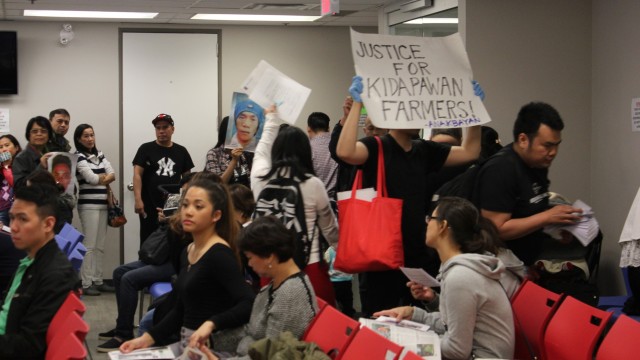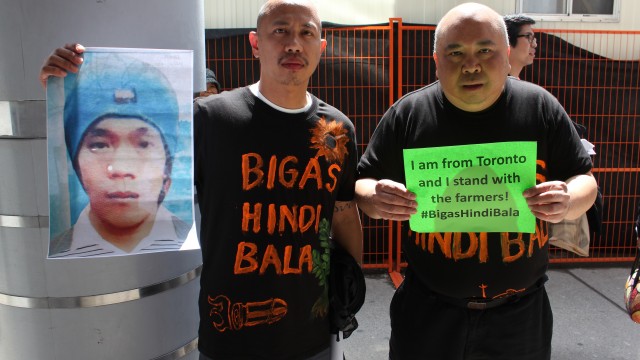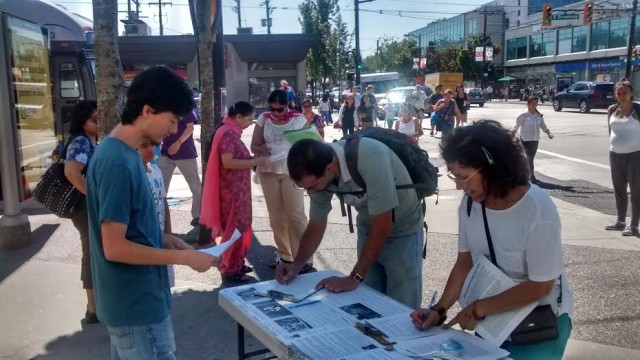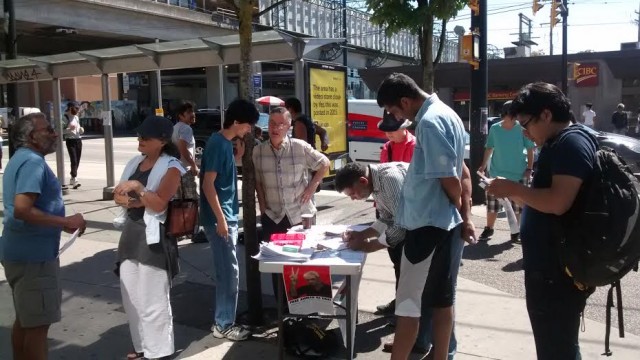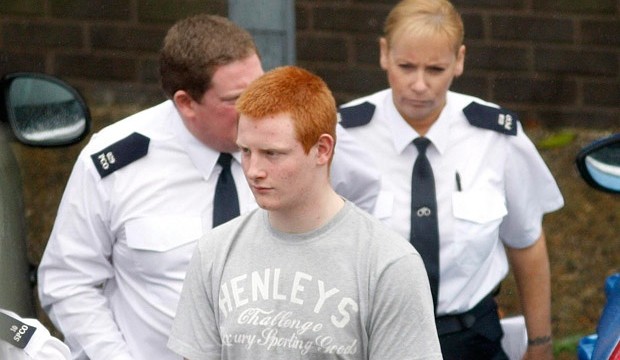A rising wave of antiwar and anti-conscription protest is taking place in cities and towns across western Ukraine. The protests are prompted by the announcement of Ukraine President Petro Poroshenko ten days ago that a “third” military mobilization is now required for the war that his governing regime began waging against the population of eastern Ukraine three months ago. Kyiv calls the war an “anti-terrorist operation.”
The protests are paralleled by a rise in Ukraine army desertions and refusals of men and women to heed conscription orders.
Poroshenko’s mobilization proposal was approved by the Ukraine Rada on July 22. The measure means that more people will be conscripted into military service and that more reserve army units will be thrown into the battle theatre.
Since the crash of Malyasia Airlines Flight 17, Kyiv has embarked on a frenzied military push into southeast Ukraine to try and defeat a pro-autonomy rebellion there. It is blocking access by investigators to the MH17 crash site and the forward line of its military push consists of intense and random bombardments of towns and cities amounting to war crimes on a massive scale.
This video of shelling of an apartment block in the city of Donetsk on July 29 is an example of what is occurring. Buzzfeed reports, “Tuesday’s attack was the first time that shelling hit central Donetsk, a hitherto tranquil rebel stronghold. It left three people dead and wounded 15. The nearby city of Horlivka declared three days of mourning after heavy fire killed 17 overnight and wounded several dozen others. At least four more people died in shelling in the Donetsk suburb of Yasynuvata.”
Kyiv is in a race to defeat the rebellion before the crippling cost of it all as well as rising antiwar protests and army desertions bring its offensive to a halt. It also has to worry about anticipated revolts by the Ukraine population as a whole once the harsh consequences of the economic association agreement that Kyiv signed with the European Union on June 30 bite deeper and deeper.
Protests on the rise
Although the propaganda websites of the Kyiv government boast of the successes of its now three-month long “anti-terrorist operation” in eastern Ukraine (which it dubs its “ATO”), the special mobilization measure approved last week shows its war is in trouble. More fighting units are needed, the national treasury is effectively bankrupted by it all and there are rising numbers of desertions from the army and growing protests by mothers, wives, friends and neighbours of conscript soldiers. ICTV reports that the advisor to the Ministry of Internal Affairs, Anton Gerashenko, has announced that anyone in Ukraine who agitates on social media against the regime’s war will be arrested.
The expanding protests have multiple messages. Some oppose the war outright. Others are specifically addressing the harsh and dangerous conditions that soldiers are facing in the east.
One of the most dramatic of the many protests since the “third mobilization” measure was announced has been in the port and shipbuilding city of Mykolaiv (also spelled Nikolaev), on the Black Sea, east of Odessa. Mothers and wives of soldiers repeatedly blocked the Varvarovsky Bridge over the Bug River for three days beginning July 25. They demanded a return of their sons or husbands from lengthy tours of duty in the 79th Paratroop Regiment. The tours have been extended and the regiment has suffered intense combat.
The women went on foot to the bridge carrying placards reading “Save our boys!” and used a pedestrian crossing to block traffic. Tussles with police and militia took place. (See dramatic video footage here from July 25.)
On the first day of the protest, the women drafted a letter to President Poroshenko which the mayor of the city and regional governor agreed to deliver. The women said their action would not end until they received a satisfactory reply. They didn’t receive that. A police mobilization ended the blockade on July 27. Some protesters were arrested.
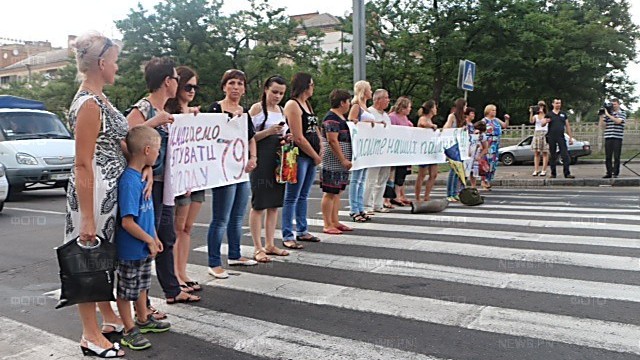
The websites Hronika.info and ZIK.ua report that in the town of Bohorodchany in Ivano-Frankivsk oblast (region) [1], in southwest Ukraine bordering the Carpathia region, angry people attacked the military registration office and the premises of other local organs of power on July 22. They burned conscription documents. (Ukraine language report here.)
It’s a rural region and protesters sounded a theme that is common to many of the anti-conscription protests: they say their menfolk lack proper training and equipment and therefore face “certain death” when sent to the east.
“Certain death” faced by soldiers is not a sign of a war going well. It also suggests that the most recent report of the Office United Nations High Commissioner for Human Rights reporting “at least” 1,129 killed by the war in Ukraine is seriously understated. It’s a fact that the report’s claim of “100,000” people made refugee by the war is laughingly low — Russia says more than 500,000 refugees have crossed its border since the war began in April and Ukraine admits to nearly 100,000 internal refugees.
Russia has condemned this latest report by the OUNCHR, saying, “Its key message is that the government of Ukraine is permitted to legitimately use force to restore law and order in the east of the country.”
Also on July 22, residents of the village of Skobychivka linked arms and formed a human chain to block the road from Ivano-Frankivsk to Bohorodchany, causing a kilometre-long traffic jam. The protesters held placards reading: “No Afghanistan in Ukraine!” “Send call-up notices to the children of the higher-ups!” “Return our children to us,” and “Stop the bloodshed.” A common slogan in the protests is “Refuse!”
A separate report in Vesti quoted the relatives of soldiers saying their sons were being used as “cannon fodder.” The report said people were also protesting in Yaremcha, in the same region, and in Sambor, Lviv region.
Not far from that area, in Bukovina region, residents in seven villages blocked roads on July 28. That region is southwest Ukraine includes a significant population of Romanian descent.
A video published by 112.UA shows soldiers’ relatives blocking a road in Obukhivs’kyi district, near Kyiv on July 24 demanding a return of soldiers from lengthy duty.
Protesters in the Odessa region blocked the Black Sea coastal highway for hours on July 28.
Residents of six villages in Sokyryanskyi region (Chernivtsi oblast) — Bilousivka, Lomachyntsi, Mykhalkove, Serbychany, Korman and Romankivtsi — blocked the highway between Chernivtsi and Novodnistrovsk on the morning of July 25, demanding that their menfolk not be sent to war.
Protests have gripped the entire region of Chernivtsi in southwest Ukraine. A video recording showed people saying, “We don’t war — we want peace” and “We did not raise our children for war. We will not give them our children.”
This video (screen below) shows a group of people, mostly women, from Chernivtsi who gather to confront a local military recruitment officer. They are carrying their sons or husbands’ conscription orders.
“Go fight your own war,” they tell the conscription officer, who tells locals to “go to the Internet” if they want to find out why the new mobilization is happening. He is referring to the Kyiv regime’s intensely propagandistic websites devoted to all things “ATO.” But the protesters are having none of that. They gather dozens of blue-coloured conscription orders into a pile and burn them.
As they stand around watching the flames, they’re all voicing their opinions. One mother says, “[Kyiv authorities] are fleeing like rats from a sinking ship, but they come here to take our sons and send them to death. They made the mess and now they need us to clean it up.” The conscription officer stands by helplessly. What can he do? He is following orders.
In the settlement of Marshintsi in the Novoselytskyy region of Chernivtsi, protesters blocked the entry of soldiers and police. Residents brought tyres and barricaded the road leading into the village. Many wrote letters of refusal, describing the events in the south-east as a “slaughter”.
On July 20, the Kyiv-Chop highway was blocked by local residents, mainly women, in the vicinity of the village of Hamaliivka near Lviv. A protest last month also blocked the highway. The same highway was blocked on July 28, in the villages of Rakoshyno and Znyatsevo, near the border of Slovakia and Hungary.
Here is one of the latest videos to be published on YouTube, of a protest in the town of Town of Novoselytsya in Chernivtsi oblast on July 30.
Many protests are voicing a “No Afghanistan in Ukraine” demand. This harkens back to the ten-year war that the Soviet Union fought against the people of Afghanistan, beginning in 1980. Altogether, 14,500 soldiers of the Soviet Union’s army died, 54,000 were wounded and many, many more Afghans died. The war was a major factor in the collapse of the Soviet Union, which happened not long after it withdrew from Afghanistan in ignominious defeat in 1988.
Post-Soviet, independent Ukraine later joined the U.S.-led occupation and war in Afghanistan. A small force still participates.
The well-known Ukrainian television journalist and commentator Ostap Drozdov has called for a boycott of the latest mobilization decree. The website Russkaya Vesna reports him saying: “My program yesterday (on the regional television channel ZIK) can be considered the start of an informal campaign to boycott the mobilisation. I state my intention to give my utmost support to this initiative, which goes by the provisional name “Mobilisation Equals Genocide.'”
He said, “It is very important that people who speak out against the mobilisation of the civilian population should see that they are not isolated. There are a great many of them.”
Army in trouble
Exact numbers of army desertions are not known and are the subject of considerable debate and counter-debate. This website report, for example, publishes a purported Ukraine army report saying that close to 3,500 soldiers deserted in the third week of July and that 1,600 soldiers died and 4,700 were wounded in that same time. Sources in Russia say the documents it cites are not authentic.
Here is a brief news report in which several Ukraine soldiers speak of their decision to take asylum in Russia. (Many videos of the fighting in eastern Ukraine are posted here on the “Anti-Maidan YouTube Channel.”)
This video records a protest in Kyiv of relatives of the 72nd Army Brigade that suffered heavy losses from a rocket attack some days ago. The protesters chant “Help the heroes”. A poster reads: “Send [Rada] deputies and generals to the battlefield!” They pray, and sing the Ukraine national anthem.
The Brigade was caught in a grisly cauldron in southeast Ukraine with many killed and injured and some survivors taking refuge in Russia. In this video, soldiers of the brigade speak for 13 minutes of their difficult and disturbing combat experience.
The pro-Kyiv, Interfax news service reports on 18 Ukraine soldiers who took refuge in Russia and received medical treatment.
Russia Today reported several days ago of this group of 40 soldiers who entered Russia and requested asylum.
Recasted fascist introduces conscription bill
Andriy Parubiy introduced the “third” mobilization bill to the Rada. He is Secretary of the National Security and Defense Council, a key advisory body to the President and the Parliament on military matters. He says the measure will mobilize 15 more army combat units and 44 combat support units.
Parabuiy is a renowned fascist in Ukraine who has modified his image in the past year and risen to prominence in the Kyiv regime that seized power in February of this year. Last year, he joined the Fatherland party of former Ukraine prime minister Yulia Tymoshenko and was elected to the Rada. Fatherland is a neo-conservative coalition/party.
U.S. journalist Robert Parry wrote of Paruiby earlier this year, “Parubiy is himself a well-known neo-Nazi, who founded the Social-National Party of Ukraine in 1991. The party blended radical Ukrainian nationalism with neo-Nazi symbols.
“Parubiy also formed a paramilitary spinoff, the Patriots of Ukraine, and defended the awarding [in 2007] of the title ‘Hero of Ukraine’ to World War Two Nazi collaborator Stepan Bandera, whose own paramilitary forces exterminated thousands of Jews and Poles in pursuit of a racially pure Ukraine.”
The United States is boosting its military aid and training to Ukraine. The announcement came from U.S. Ambassador to Ukraine Geoffrey Pyatt on July 25. The U.S. already committed to $23 million in equipment; that will now rise to $33 million. It is also intervening in the countries it dominates in the region to boost the training and equipping of their armed forces, including Moldova and Romania on Ukraine’s southwest frontier and Poland on the northwest.
Kyiv’s ruthless shelling and bombing of towns and cities is running out of time due to the war’s huge financial cost. Describing Ukraine’s economy, the Washington Post wrote on July 26:
“The IMF forecasts that Ukraine’s annual GDP will drop by 6.5% this year, while the government deficit is projected at 10.1% of GDP. This week, the government announced that it would need at least 800 million dollars to continue its counterinsurgency operation and asked the parliament to further increase taxes and cut public spending. The deputies’ refusal to appropriate needed funds yesterday triggered Prime Minister Arseniy Yatsenyuk’s resignation as he recognized that soldiers would receive no pay next month. The reconstruction of Donbas is even more uncertain as the government promised to turn to foreign donors for funds in the coming fall.”
In a remarkable admission last week, Ukraine’s ambassador to Canada, Vadym Prystaiko, told the Globe and Mail, “We are pouring all the money in our budget… into the anti-terrorism campaign.”
The war is scandalously riding roughshod over the international investigation into the crash of Malaysia Airlines Flight 17. Investigators were blocked from reaching the site on July 27 and in the days following by the relentless shellings and other bombings by the Ukraine army in the region.
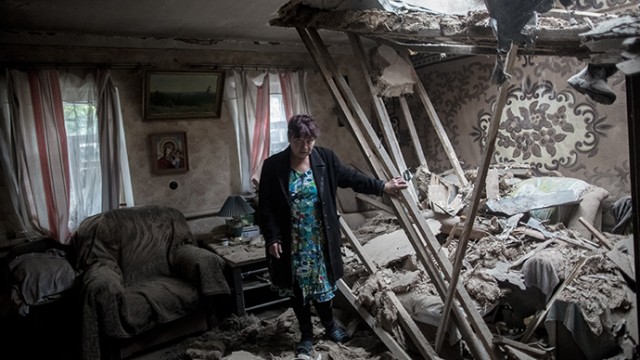
A woman stands in her home destroyed in the Ukrainian troops’ shelling of the Golubovka village near Slavyansk on June 27, 2014. (RIA Novosti / Andrey Stenin).
As reported by international media, inspectors are lodged in hotels in Donetsk each night and the passed easily through self defense lines surrounding the city to get to the site. But as the days wore on, the international media reported the blockage as due to “fighting” and “clashes.”
On July 30, Kyiv propaganda began saying that rebel fighters had placed mines on the crash site and were shelling it. That story evaporated the following day when, in circumstances unexplained, inspectors finally reached the site.
The grim reality of Kyiv’s military campaign in eastern Ukraine has been airbrushed out of mainstream news reporting. Little or no visual presentation of bombardments or other war crimes is allowed to pass through editorial filters. The war and its consequences are explained away in the vacuous language of “fighting” or “clashes” taking place. The Toronto Star‘s Tanya Talaga began a front-page article on July 30 with, “The European Union and western nations joined on [July 29] to try to force Russian President Vladimir Putin to stop his military aggression in Ukraine…” (Inside the same edition, the Star published a factual account of the bombardments of cities and towns.)
The European Union is matching the Ukraine army offensive by upping its economic sanctions on Russia. The sanctions are punishment for Russia’s refusal to obey U.S. and European demands that it police the pro-autonomy movements in eastern Ukraine and pressure them to surrender. They are also part of the long-standing drive by the member countries of the NATO military alliance to weaken and isolate Russia.
The rising antiwar movement in Ukraine has profound consequences for the future of the country. Will protests stop Kyiv’s war before southeast Ukraine is reduced to ruin? Will Ukrainian as well as international protests give pause to the military planners at NATO who are increasingly training their sites on Russia?
Ukraine’s economic elite has made a sharp turn to embrace austerity Europe. The kind of austerity consequences that have ravaged Greece and other countries of southern Europe await the Ukrainian people. How will the antiwar protesters and other ordinary Ukrainians react as the government deepens unpopular cuts to social programs and subsidies that reduce the cost of essential items?
Protests around the world are needed to stay the hands of the warmakers in southeast Ukraine. Solidarity actions can stop the killings. They can also help Ukrainians to chart a different path of economic and social development. That would be fitting because anti-austerity sentiment was at the heart of the rebellion in eastern Ukraine in the first place.
A new, 80-minute video compilation, Ukraine Crisis, has been produced that provides a powerful record of the war in eastern Ukraine during the past month. A warning, there are some scenes of death and destruction caused by the Kyiv government’s shelling that are disturbing, particularly in the four to six minute section, inclusively. The testimony of the woman who speaks for five minutes at the 1’17″30 mark is especially insightful and heartrending. She has lost her son to the war, not knowing since March if he is dead or alive. She asks, “What has become of this Ukraine nation?”
This article draws in part from a July 28, 2014 article from the Russian website Rabkor (“Worker Correspondent”) which was translated into English by Renfrey Clarke.
Notes:
[1] Ukraine is subdivided into 25 regions: 24 oblasts (regions, or provinces) and one city with special status, Kyiv. Two former oblasts — Donetsk and Luhansk — voted in May for autonomy. The ferocity of Kyiv’s war is driving those two regions to a de facto secession.
]]>
